
William Etty was an English artist best known for his history paintings containing nude figures. He was the first significant British painter of nudes and still lifes. Born in York, he left school at the age of 12 to become an apprentice printer in Hull. He completed his apprenticeship seven years later and moved to London, where in 1807 he joined the Royal Academy Schools. There he studied under Thomas Lawrence and trained by copying works by other artists. Etty earned respect at the Royal Academy of Arts for his ability to paint realistic flesh tones, but had little commercial or critical success in his first few years in London.

Henry Scott Tuke, was an English artist; primarily a painter, but also a photographer. His most notable work was in the Impressionist style, and he is best known for his paintings of nude boys and young men.

Benjamin Williams Leader was a British landscape painter.

Sir Arthur Ernest Streeton was an Australian landscape painter and a leading member of the Heidelberg School, also known as Australian Impressionism.
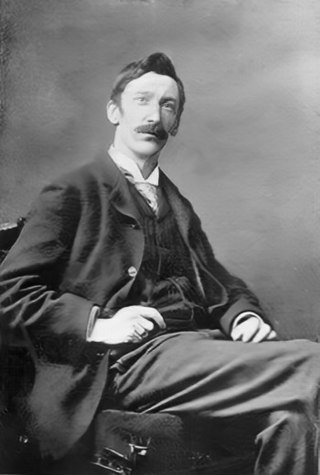
Stanhope Alexander Forbes was a British artist and a founding member of the influential Newlyn school of painters. He was often called 'the father of the Newlyn School'.

Albert Chevallier Tayler was an English artist who specialised in portrait and genre painting, but was also involved in the plein air methods of the Newlyn School. He studied at Heatherley's School of Art, Royal Academy Schools and with avant-garde painters in Paris. He was educated at Bloxham School in Oxfordshire.
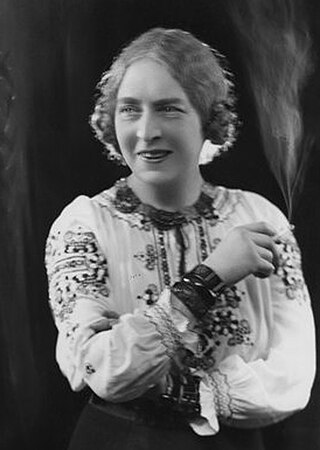
Dame Laura Knight was an English artist who worked in oils, watercolours, etching, engraving and drypoint. Knight was a painter in the figurative, realist tradition, who embraced English Impressionism. In her long career, Knight was among the most successful and popular painters in Britain. Her success in the male-dominated British art establishment paved the way for greater status and recognition for women artists.

Walter Langley was an English painter and founder of the Newlyn School of plein air artists.
Mildred Anne Butler was an Irish artist, who worked in watercolour and oil of landscape, genre and animal subjects. Butler was born and spent most of her life in Kilmurry, Thomastown, County Kilkenny and was associated with the Newlyn School of painters.
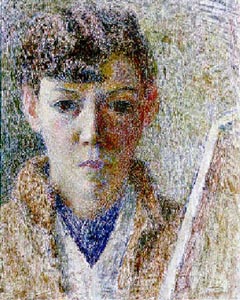
Dod Procter, born Doris Margaret Shaw, (1890–1972) was an English artist, and the wife of the artist Ernest Procter. Her painting Morning was bought for the public by the Daily Mail in 1927.

Frank Bramley RA was an English post-impressionist genre painter of the Newlyn School.
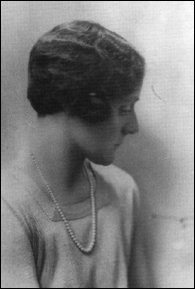
Kathleen "Kay" Moir Morris was a Canadian painter and member of the Beaver Hall Group.
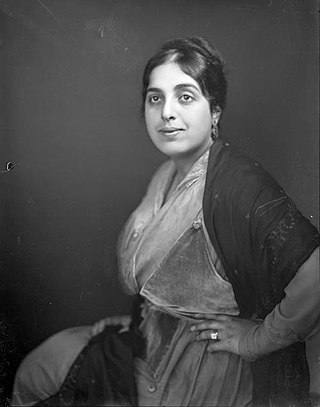
Hermina "Mina" Arndt was a New Zealand artist.

Candaules, King of Lydia, Shews his Wife by Stealth to Gyges, One of his Ministers, as She Goes to Bed, occasionally formerly known as The Imprudence of Candaules, is a 45.1 by 55.9 cm oil painting on canvas by English artist William Etty, first exhibited at the Royal Academy in 1830. It shows a scene from the Histories by Herodotus, in which Candaules, king of Lydia, invites his bodyguard Gyges to hide in the couple's bedroom and watch his wife Nyssia undress, to prove to him her beauty. Nyssia notices Gyges spying and challenges him to either accept his own execution or to kill Candaules as a punishment. Gyges chooses to kill Candaules and take his place as king. The painting shows the moment at which Nyssia, still unaware that she is being watched by anyone other than her husband, removes the last of her clothes.
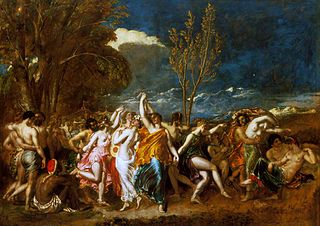
The World Before the Flood is an oil-on-canvas painting by the English artist William Etty, first exhibited in 1828 and currently in the Southampton City Art Gallery. It depicts a scene from John Milton's Paradise Lost in which, among a series of visions of the future shown to Adam, he sees the world immediately before the Great Flood. The painting illustrates the stages of courtship as described by Milton; a group of men select wives from a group of dancing women, drag their chosen woman from the group, and settle down to married life. Behind the courting group, an oncoming storm looms, foreshadowing the destruction which the dancers and lovers are about to bring upon themselves.
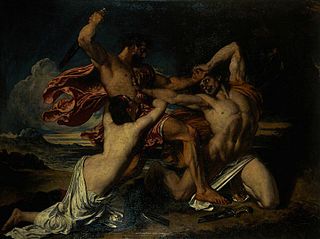
The Combat: Woman Pleading for the Vanquished is a large oil painting on canvas by English artist William Etty, first exhibited in 1825 and now in the National Gallery of Scotland. Inspired by the Elgin Marbles and intended by the artist to provide a moral lesson on "the beauty of mercy", it shows a near-nude warrior whose sword has broken, forced to his knees in front of another near-nude soldier who prepares to inflict a killing blow. A woman, also near-nude, clutches the victorious warrior to beg him for mercy. Very unusually for a history painting of the period, The Combat does not depict a scene from history, literature or religion and is not based on an existing artwork, but is instead a scene from the artist's own imagination.
Alethea Garstin (1894–1978) was a Cornish artist and illustrator who exhibited paintings regularly at London's Royal Academy from an early age.
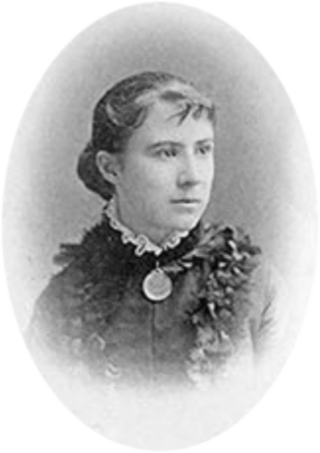
Harriet Mary Ford or simply Harriet Ford was a Canadian artist who worked as a painter, muralist and jeweller. She has been described as epitomizing "the Canadian New Woman". Ford was active as a critic, writer, and lecturer, and was known in academic circles as an authority on Renaissance art and artists. Ford belonged to a number of societies and organizations and founded the Society of Mural Decorators in 1894.
Joan Manning-Sanders was a British artist regarded as a child prodigy.
















